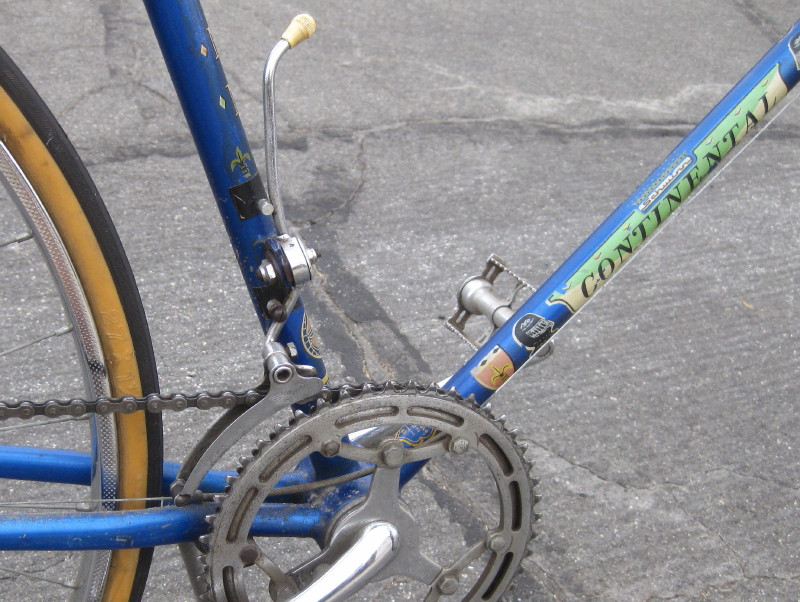Growing up, bikes were more than just toys; they were keys to freedom. As a kid, the thrill of late-night rides under the stars, without bike lights, was pure liberation. However, as my cycling ambitions grew, my trusty single-speed bike started to feel limiting. I vividly remember my first long ride to the beach with a friend. While I furiously pedaled my Stingray, struggling to keep pace, he effortlessly cruised along on his Ten Speed Bike. That’s when the realization hit me: gears were essential. I needed a ten speed bike.
The local swap meet became my go-to destination. I spent countless hours there, buying, fixing, riding, and reselling ten speed bikes. Schwinns were the bikes to have back then, so most of them were. Many were Varsity models, some even with the early 8-speed systems. Others were Continentals, boasting nicer components and superior brakes. Eventually, I owned a brand-new white Varsity, which I promptly sold to a friend the moment I got my driver’s license. The allure of motorcycles and hot rods overshadowed those early cycling memories for a while.
Fast forward about twenty years, a gift – a 1960s Schwinn Collegiate – reignited my passion for bikes. This rekindled love led me to search for a bike reminiscent of my childhood. This week, my search culminated in a significant find: a truly special bike. It’s beautifully colored, almost entirely original, and in remarkably good condition. It features unique graphics on the frame and a distinctive front derailleur mounted on the seat tube. A bit of online research confirmed my hopes – this was indeed the bike I had been dreaming of.
The seller, a young man, had recently acquired it from an estate sale. He had thoughtfully tuned it up, fitted new tires and tubes, replaced the original derailleur with a quality vintage Suntour unit, and upgraded the worn-out Ideale leather saddle to a comfortable Brooks. He also added new bar tape and cables. Although he enjoyed riding it, his heart was set on a fixie. Recognizing the vintage value of this Schwinn Continental, he decided to sell it to fund his fixie project. That’s where I came in, acquiring it for less than the cost of the repairs and upgrades he had already invested.
My online research unveiled fascinating details about this model. The Schwinn Continental ten speed bike was offered in radiant red, radiant green, radiant blue, coppertone, and black. It was promoted as Schwinn’s fastest bike for sport riding. It marked Schwinn’s entry into the growing American market for European-style ten speed bikes. It’s a lightweight machine, weighing in at around 30 lbs on my scale, and packed with cool features.

The standout feature, and a key element of my nostalgic search, is the “suicide” front derailleur. This type of shifter was common on many ten speed bikes of my youth. I remember customizing the levers with laminated plastic knobs in various colors. Now, I’m on the hunt for a unique replacement for the plain white nub that came standard on this lever.
While browsing eBay to gauge the rarity of my new acquisition, I stumbled upon a listing for a NOS (new old stock) 1960 Continental from a seller in Los Angeles. He’s asking a considerable price for his bike, which is in pristine condition. However, our email exchange proved invaluable, as he provided details about the original trim and colors of components that have been changed on my bike, such as the light grey cable housings (mine are currently white) and the medium blue bar tape (mine is black). If you’re interested in a bike like this, I recommend checking out his eBay listing.
Although my Schwinn Continental is perfectly rideable as it is, I plan to disassemble it for a complete mechanical overhaul. My to-do list includes a thorough polishing of every part. I’m hesitant to touch up the frame scratches, but I will certainly clean and lubricate everything meticulously. I might also pursue restoring some details to bring it closer to its original appearance. I have a Schwinn rack and a vintage saddlebag that I think will complement it perfectly. The Brooks leather saddle, while not original, is a welcome upgrade. The original rims need some spoke tightening and elbow grease to shine and spin smoothly. This restoration project promises to be a fun journey back in time.
I’ve even entertained the idea of taking it to the local velodrome on practice days for some track riding. I’m no racer, but the thought of riding on the banked track and imagining myself in a race is thrilling. A Walter Mitty moment in the making! Even just riding it around the neighborhood has brought a wide smile to my face.
The truth is, I didn’t need another bike. I’m already deeply involved in restoring three old English 3-speeds (as detailed in a previous article), and my e-bike experiments are progressing beyond my expectations. Realistically, I can only ride one bike at a time, yet the desire for more persists. I had repeatedly told myself to resist if I found this particular bike. I assumed the price would be prohibitive enough to deter me. However, this 50-year-old dream bike is now mine, and I’ve already enjoyed several rides. Sometimes, things just align perfectly.
I’ll be sure to share updates on my restoration progress and the joy this bike brings me. More photos are definitely coming. I’m excited about this opportunity to delve deeper into the history of bikes, and Schwinn bikes in particular. When I first worked on and rode these bikes, they were almost new. Now, 50 years later, it feels new all over again. Do things truly change? Perhaps I’ll see you at the velodrome, Turbo Bob.
“I turned back the clock almost fifty years with just one shift on the front chain ring”.—Turbo Bob, riding his (brand-new) Schwinn Continental ten speed bike.
Follow this link to see my Continental on YouTube:

